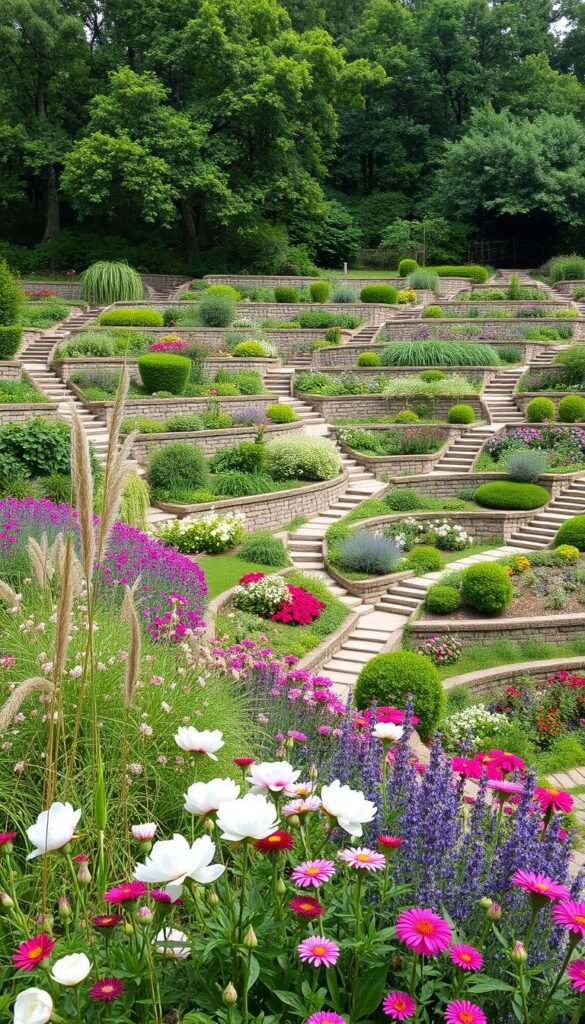Does your sloped yard feel like wasted space? Imagine transforming it into a cascading paradise where every level serves a purpose. Terraced gardens turn challenging landscapes into functional outdoor retreats, blending beauty with practical solutions like erosion control.
By working with your land’s natural slopes instead of fighting them, you create distinct zones for relaxation, gardening, or entertainment. For example, upper tiers could host vibrant flower beds while lower areas become cozy seating nooks. Discover innovative terraced garden ideas that turn elevation changes into design opportunities.
These layered spaces do more than look stunning—they double your usable area. A well-planned layout lets you grow vegetables on one terrace and entertain guests on another. Even narrow slopes become valuable when using vertical elements like climbing plants or tiered planters. Pair this approach with vertical container gardening hacks for maximum impact.
Ready to reimagine your outdoor space? We’ll show you how to combine smart planning with creative flair to build a multi-level oasis that impresses neighbors and thrives season after season.
Embracing the Terraced Garden Lifestyle
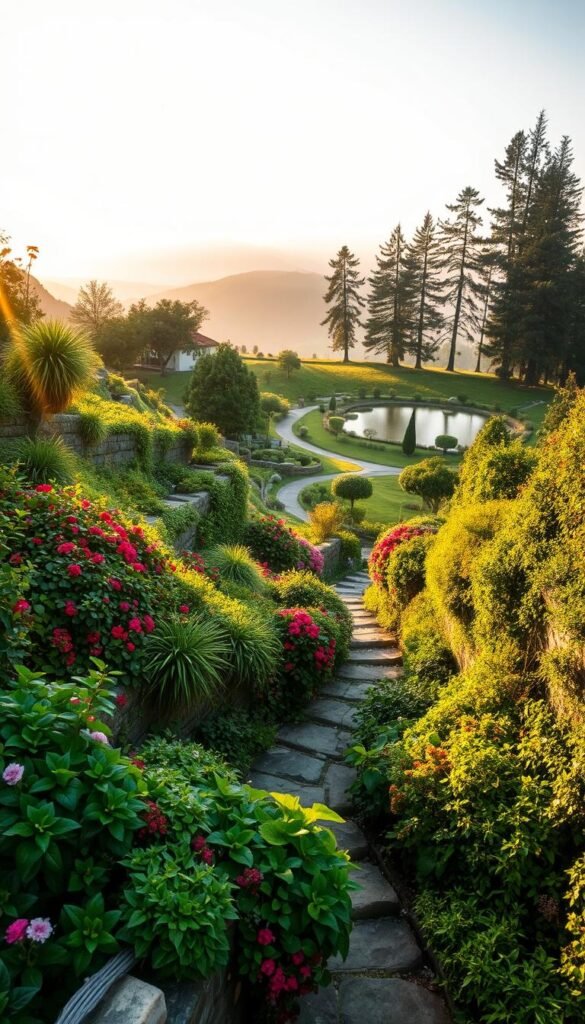
Unlock the hidden potential of your uneven yard with tiered designs that blend nature and function. These layered spaces create personalized zones for dining, growing herbs, or soaking in mountain views—all while working with your land’s contours.
Discovering the Advantages of Multi-Level Yards
Your sloped property becomes a canvas for creativity. Elevated sections naturally block wind and noise, while lower areas stay cooler for summer gatherings. This setup lets you:
- Grow sun-loving plants on upper tiers
- Create shaded seating nooks below
- Prevent soil erosion with strategic planting
Transforming Uneven Spaces into Outdoor Retreats
What seems like challenging terrain actually offers design perks. Steep slopes become cascading flower beds, while gentle inclines host stone pathways. You’ll gain usable square footage without costly flattening.
| Feature | Flat Yard | Tiered Design |
|---|---|---|
| Privacy Levels | Limited | Natural separation |
| Plant Variety | Single zone | Multiple microclimates |
| Visual Interest | 2D layout | 3D depth |
This approach boosts your home’s curb appeal and creates year-round interest. Neighbors will admire how you turned a tricky landscape into a thriving ecosystem.
What is a Terraced Garden?
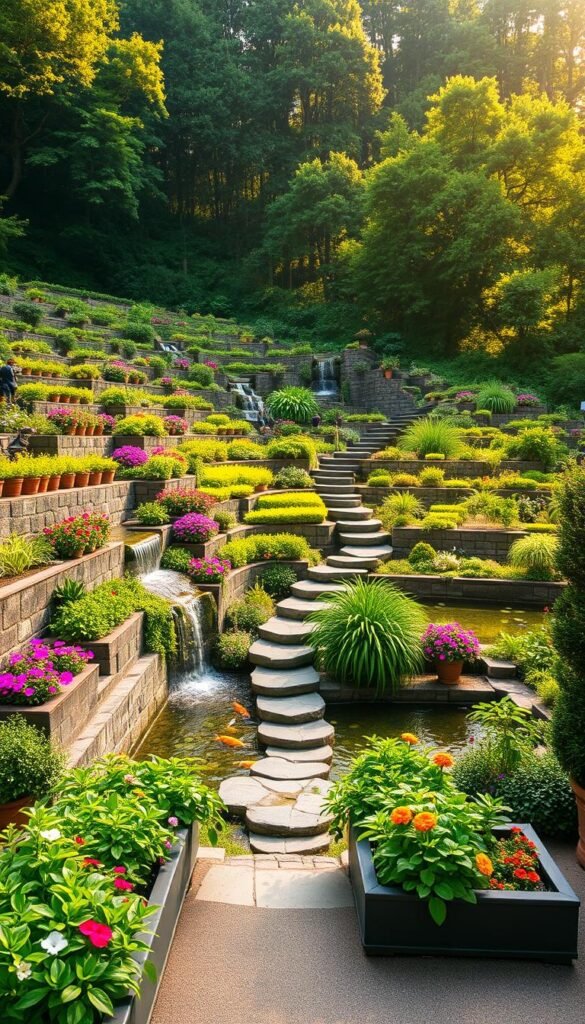
Sloped landscapes often get labeled as problematic, but they hold untapped potential. Terraced gardens reshape challenging elevations into organized, productive areas through intentional design. These systems use retaining walls or containers to create flat zones where plants thrive and water behaves predictably.
Types of Terrace Designs
Two approaches dominate terrace gardening. Urban versions transform rooftops into lush escapes using pots and raised beds. Hillside designs rely on stone or timber walls to carve stable planting platforms from slopes. Both methods turn awkward spaces into functional growing areas.
| Design Type | Location | Structure | Best For |
|---|---|---|---|
| Container-Based | Rooftops/Patios | Movable planters | Herbs & Flowers |
| Hillside Terracing | Natural Slopes | Retaining walls | Vegetables & Shrubs |
Benefits for Erosion Control and Space Maximization
Steep ground loses 8 times more soil than flat areas during storms. Terraced layouts combat this by:
- Slowing rainwater flow with leveled sections
- Trapping sediment behind walls
- Encouraging deep root growth
Each terrace acts like a stepped sponge, absorbing moisture while protecting the slope below. You gain usable planting zones where before there was only erosion risk.
Choosing the Right Design for Your Slope
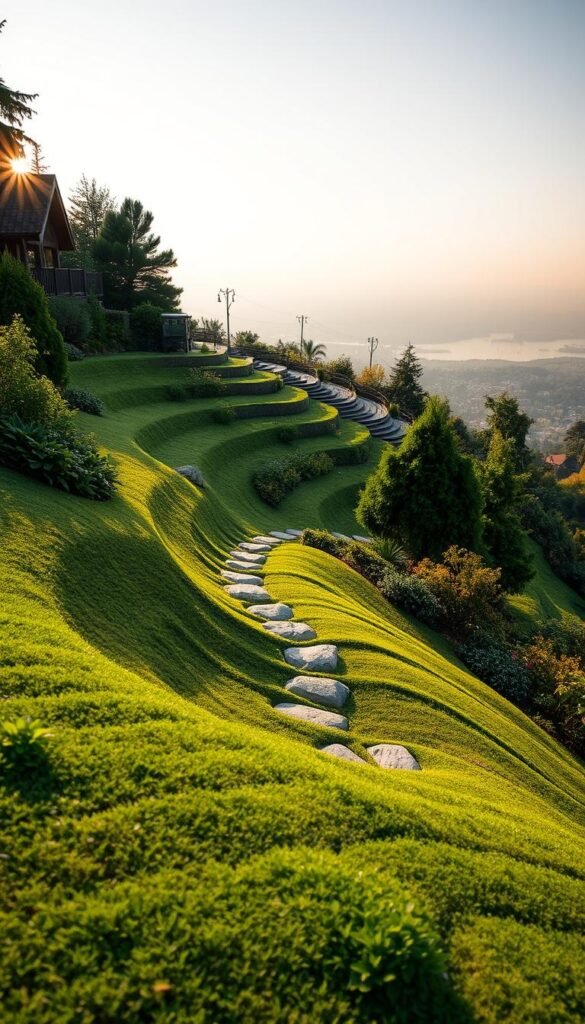
Your slope’s personality determines its perfect layout. Like matching shoes to an outfit, the design should complement your land’s natural curves and angles. Start by measuring the steepness—gentle inclines under 30% allow creative freedom, while steeper grades demand strategic planning.
| Slope Type | Design Features | Materials | Plant Choices |
|---|---|---|---|
| Gentle (5-15°) | Low walls, curved paths | Timber, gravel | Groundcovers, perennials |
| Steep (15-30°) | Reinforced terraces, steps | Concrete, stone | Deep-rooted shrubs |
Walls taller than 2 feet need professional input. “Proper planning prevents walls from becoming leaning towers of soil,” says a Colorado landscape architect. Always angle retaining walls inward—1 inch per foot of height—for stability.
Consider how sunlight dances across your slope throughout the day. South-facing terraces bake in full sun, ideal for lavender or rosemary. Shaded northern exposures suit ferns and hostas. Mix materials like stone and wood for visual harmony, or try container gardening on upper levels for movable color.
Your final layout should feel like a natural extension of the surrounding landscape. Curved terraces mimic rolling hills, while angular designs echo modern architecture. Leave room between levels for maintenance access—your future self will thank you when pruning season arrives.
7 Terrace Garden Ideas to Maximize Multi-Level Yards
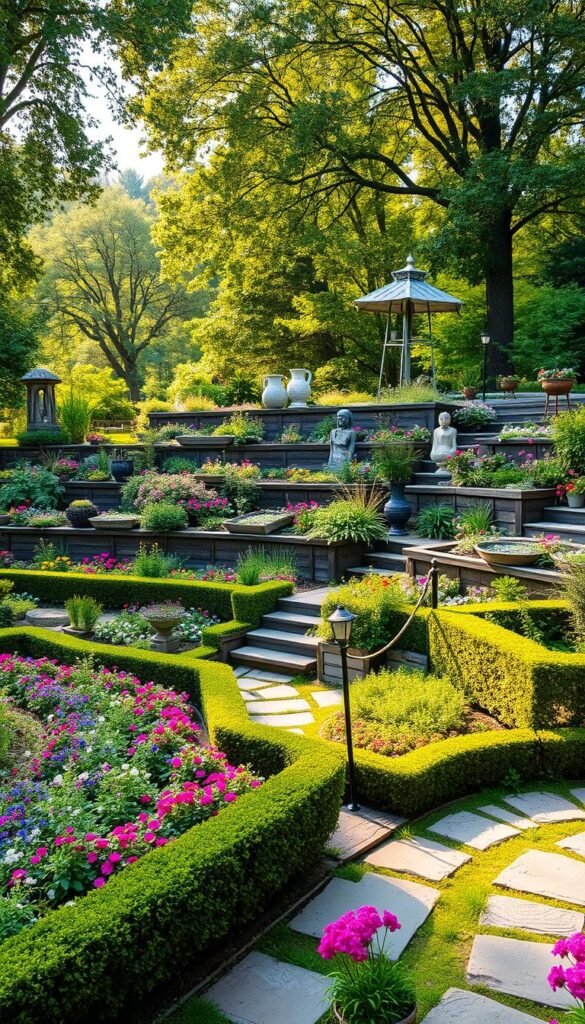
Transform your sloped landscape into a vibrant living canvas with these layered design concepts. By working vertically, you unlock hidden potential in every tier. Connected planting beds create visual flow while serving practical purposes like erosion control.
Water becomes your ally in sloped spaces. Gravity-fed cascades between levels add soothing sounds and movement. Pair stone-lined channels with moisture-loving plants like ferns or hostas for natural harmony.
| Feature | Purpose | Best Plants |
|---|---|---|
| Sunlit upper tiers | Vegetable production | Tomatoes, peppers |
| Shaded lower areas | Entertainment zones | Ornamental grasses |
| Mid-level platforms | Mixed-use spaces | Herbs, dwarf shrubs |
Drought-resistant varieties thrive on exposed upper levels. Rosemary and lavender bring fragrance while needing minimal watering. Below, create sheltered nooks with native species that attract butterflies.
Fire pits or built-in seating turn steep sections into social hubs. Use natural stone for retaining walls that double as casual benches. This approach blends functionality with relaxed charm.
Your layered landscape can produce food and beauty simultaneously. Leafy greens grow well under fruit trees, while flowering vines soften stone walls. Every level tells its own story.
Creative Planting and Gardening Tips
Your layered landscape becomes a living masterpiece when plants thrive in their ideal spots. By understanding each terrace’s unique conditions, you create a resilient ecosystem that evolves through the seasons.
Sunlight and Soil Savvy Plant Choices
Upper terraces bake in full sun with fast-draining soil—perfect for rosemary or thyme. Middle levels suit tomatoes and peppers that need steady moisture. At the base, ferns and hostas drink up rainwater runoff.
| Terrace Level | Plant Types | Root Depth | Purpose |
|---|---|---|---|
| Upper | Lavender, sedum | Shallow | Erosion control |
| Middle | Daylilies, shrubs | Medium | Visual interest |
| Lower | Astilbe, moss | Deep | Moisture management |
Year-Round Garden Care Tactics
Test soil pH each spring—acid-loving blueberries won’t thrive beside alkaline-preferred lilacs. Refresh mulch in fall to protect roots during frosts. Native plants like coneflowers need less fuss while supporting local wildlife.
Mix evergreens with seasonal bloomers for continuous color. Swap summer annuals for cold-hardy pansies when temperatures drop. For more creative sloped garden layouts, explore designs that work with your land’s natural flow.
Deep-rooted grasses stabilize slopes better than concrete in some cases. Pair them with creeping juniper for textured groundcover that withstands foot traffic. Your garden becomes low-maintenance when every plant has a purpose.
Integrating Water Features and Efficient Irrigation
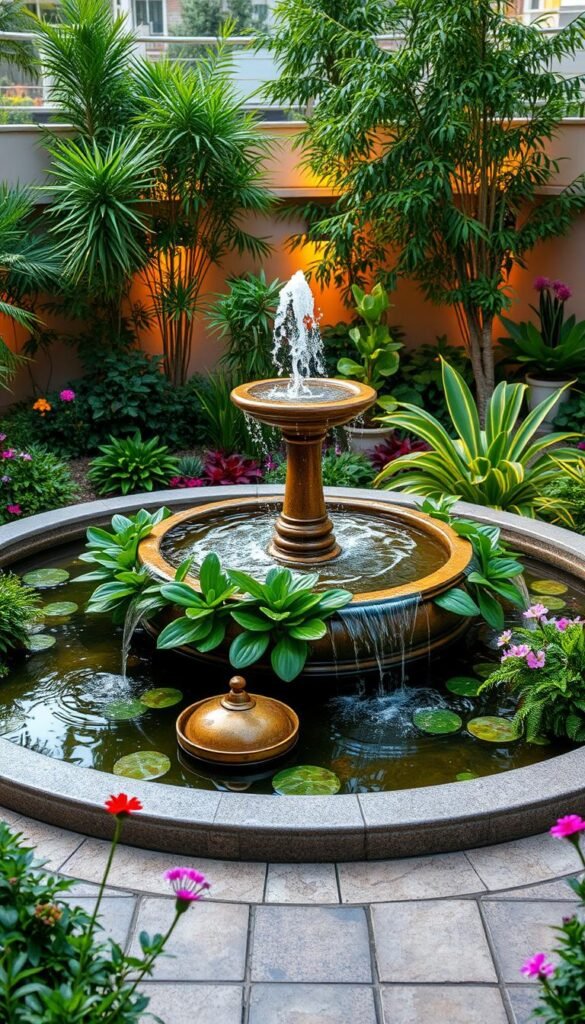
Your sloped landscape becomes a water-wise wonderland when you combine smart irrigation with eye-catching features. Gravity becomes your best friend here, helping water flow naturally between levels while creating soothing visual elements.
Designing Water Elements That Complement Your Levels
Stone-lined rills guide rainwater between terraces like natural streams. These channels do double duty – they look beautiful and prevent soil erosion. Plant moisture-loving ferns along the edges to filter runoff naturally.
| Water Feature | Materials | Maintenance Level |
|---|---|---|
| Cascading fountain | Recycled stone | Low |
| Tiered planters | Weather-resistant resin | Medium |
| Dry creek bed | Local river rock | Minimal |
Setting Up a Simple Irrigation System
Modern drip kits make watering slopes surprisingly simple. Flexible tubing snakes through planting beds, delivering hydration exactly where roots need it. Pair with smart timers to:
- Adjust schedules based on weather forecasts
- Control different zones from your phone
- Save 30-50% water compared to sprinklers
Capture rainwater from upper levels in decorative barrels. Use this free resource to water lower terraces during dry spells. This closed-loop system keeps plants happy while reducing your water bill.
Enhancing Aesthetic with Natural Materials and Lighting
Your multi-level garden becomes an evening masterpiece when natural textures meet strategic illumination. Start by selecting materials that mirror your home’s character—weathered wood for rustic charm or sleek concrete for modern flair. Local stone blends effortlessly with existing landscapes, creating walls that look like they’ve always belonged there.
Clever lighting transforms safety into style. Recessed LEDs along steps clarify elevation changes while casting soft glows. Uplights behind boulders or shrubs carve dramatic shadows across stone surfaces after dark. Solar-powered options work wonders for eco-conscious designs, charging by day and glowing at night.
| Material | Best Use | Benefits |
|---|---|---|
| Limestone | Mini retaining walls | Natural erosion control |
| Slate | Pathway accents | Slip-resistant texture |
| Reclaimed timber | Planter edges | Warm, weathered look |
Repeat key elements across levels to unify your design. Match pathway stones with wall materials, or echo metal light fixtures in planter details. This visual rhythm guides the eye smoothly through each terrace.
Choose fixtures that withstand weather while enhancing ambiance. Copper lanterns develop patina over time, adding character. For subtle lines, embed low-voltage strip lights under bench seats or along handrails. Your garden will feel inviting long after sunset.
Balance rugged stone with soft greenery for harmony. Moss fills gaps between pavers, while ornamental grasses sway beside angular boulders. The right mix turns functional structures into living art that evolves with the seasons.
DIY Tips and Budget-Friendly Solutions for Terraced Gardens
Building your dream landscape doesn’t require deep pockets—just smart strategies. Start small with manageable projects that let you hone skills before expanding. The key lies in choosing materials wisely and working with your land’s existing features.
Retaining Wall Construction and Material Choices
Short retaining walls under two feet tall offer a perfect DIY entry point. Dig a trench slightly wider than your chosen timber, then layer boards horizontally. Backfill with soil from higher ground to create level planting areas. Reclaimed railroad ties or broken concrete blocks add character while cutting costs.
Budget Planning and Smart Resource Use
Scout local construction sites for free stone or check community boards for leftover materials. Gabion cages filled with rubble make sturdy walls that double as drainage solutions. Phase projects over seasons to spread expenses—build one terrace this year, add another next spring.
Mix practicality with creativity. Old wine barrels become instant planters for upper tiers. Use native plants that thrive in your existing soil to reduce amendments. With these approaches, your layered landscape grows smarter—not harder—on your wallet.

